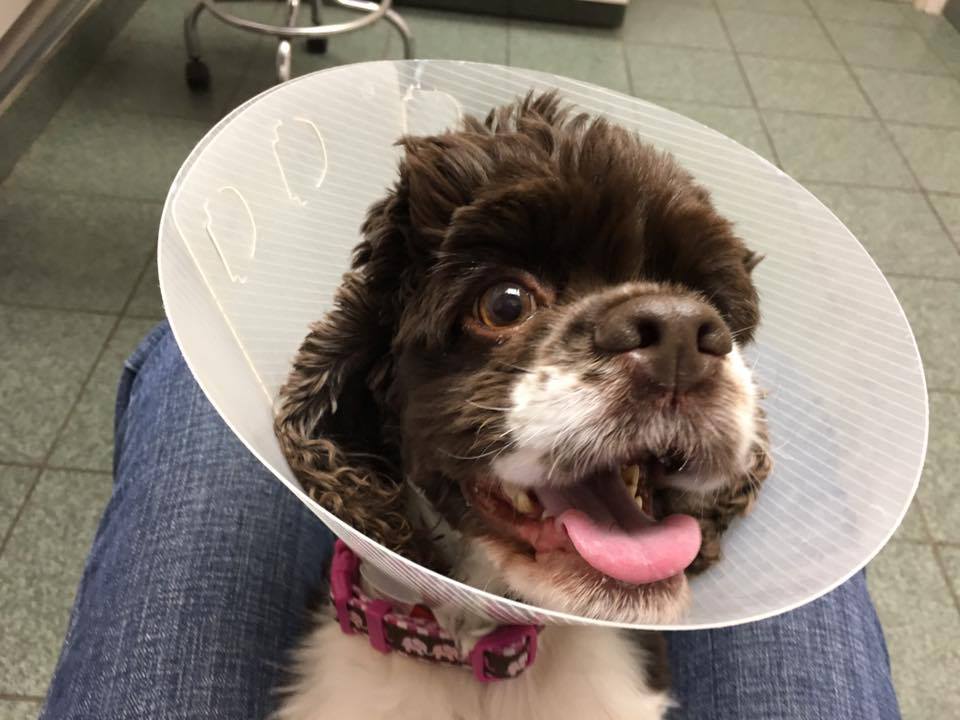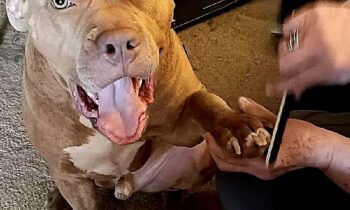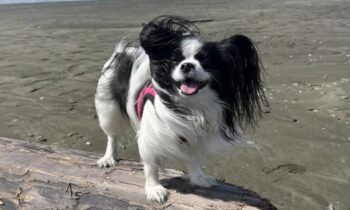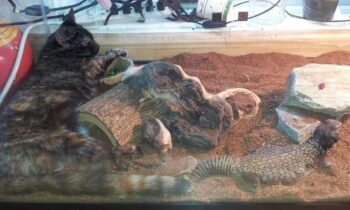
In the last few weeks, I’ve shared my own personal experiences with using an Elizabethan collar. I bet my dog, if he could, would have some choice comments to add, now that he is cone-free!
I asked dog lovers and dog professionals from around the world to tell us their stories, funny and not-so-funny, about the Elizabethan collar (commonly known as the cone of shame) and their own dogs.
Peggy Modjeski (Kentucky) I have never been able to keep a “cone” on an Aussie. My Quinn, for example, will sit quietly in a puppy exercise pen that is 18 inches tall and not try and escape no matter what’s going on. I got that behavior by never picking him up to get him out of the pen as a puppy and only releasing him through the gate. However . . . he can open doors, climb a privacy fence, and get one of those cones off in less than five seconds. He’s like an escape artist. Except from the puppy pen.
Micha Michlewicz (Maryland) My standard poodle outsmarted everything we put on her—cone, bumper, body suit, Ace bandage, and pads. We had to end up using them ALL and we had to keep putting her dressing back into place. It was at her hip. It was for a couple of weeks. That was fun!
Steve Christilaw (Washington) When River first wore her cone of shame, she refused to walk forward while wearing it. She would only back up. When you have a young Great Dane who still hadn’t figured out how far her butt is from her head, that leads to some hilarious moments.
Toni Vignogna (California) Stella would spit out her pain pills into the cone. It would catch the edge of the recliner when she tried to get up on it.

Photo by Toni Vignogna
Jett Wyatt (Oregon) When Rowan had to wear a cone (stitches in her side), she could not have cared less. Ran through the door, hit the jamb, and just kept going. The cone the vet gave me was trash in 36 hours. The one I bought lasted her ten days but was trash when it was over. The funniest thing was that I discovered how closely Aussies follow their humans because she kept tapping the back of my legs with the cone when I walked through the house!
Jill Gibbs (Montana) I decided that having bruises on the back of my legs was too much, so my dogs have a soft cone now. I swear they run into me on purpose.
Kathy Smith (South Carolina) Indy was feeling no pain once the meds kicked in. (Allergies had him licking his foot raw.) I watched him try to lick the foot through the cone, lift his head up as to wonder why that didn’t work, and try again. Eventually we got it under control and he is free of the evil cone of shame . . . until next fall.
Kathy L Wagner (Washington) We took Marley [in a cone] to a friend’s place out in the country. They had chickens roaming in the yard. It’s okay, they said. Next thing we knew, Marley flew off the deck like Super Dog. A chicken was quickly covered with the cone and disappeared. Before we could get off the deck, Marley raised her head and the chicken took off, feathers flying everywhere. Marley had the funniest expression on her face and the inside of the cone was covered with feathers. The chicken was okay, just missing a few feathers.
Mandy Collins (United Kingdom) Heard whining. Dog got stuck trying to come through the back door.

Photo by Mandy Collins
Margaret Tyler (Illinois) Tess, after surgery to combat megaesophagus that put a tube into her stomach so she could be fed (and one from the nose into the esophagus so I could suction out the goop that collected there), wore a small cone to start with. She managed to remove the second tube, cone or no. Second try, bigger cone. She managed to remove the tube. Third try, huge cone. She was due for her appointment to possibly remove the tube on Halloween, so I was painting the outside of it so she could go to her appointment as a purple coneflower. Then she managed to chew the tube off and regurgitate the bottom half of it, the part that had been in the esophagus. At that point, we just pulled the rest and gave up on that tube, which luckily she didn’t need any more. I never finished the paint job! Tess was a golden girl who was four at the time. Now she’s without any tubes, all GRLS labs come back normal, and she’s happy as can be eating upright on her stool and doing upright time afterwards.
Katharine Weber (Illinois) I’ve had several ‘experiences’ with the cone of shame.
First was with my dog Snapper, post neuter, who would not move with a cone on his head. Remained frozen in place. I had to lead him around by the cone and when I let go, he froze. He tricked me into thinking dogs with cones were easy to deal with.
But next came Echo. He ate a bottle of ibuprofen. He was at the vet’s for several days while they flushed his kidneys continuously with IV fluids. He never felt bad, as in sick (he was never remorseful), and after a day or so, he started pulling out the IV line from his leg. So they put a cone on him. I got a call to come and get him. He’d started to chew off the IV line leading from the bag. He could reach that! He continued with sub Q fluids. Moral here? There’s always something within reach. Which he proved again when he had a growth removed from his paw. We were sure he couldn’t reach the incision with the cone on. But he somehow untied the sutures!! I had a friend hold him down while I retied the sutures. With two tweezers. My vet was impressed. She’d cut those threads pretty short. Moral here: even when you can’t get a good grip on what you want to chew, work at what you can reach.
My dog GoFer was my next cone challenge. I don’t recall why or where she had an incision. She was indignant about having to wear a cone. She wasn’t about to let any cone stop her from whatever she wanted to do. She bashed that cone into everything. She never slowed down one step. Bashed into trees she ran by. Bashed into walls and furniture. The final straw was running through the dog door at full speed. In a short time, there were just shreds of plastic hanging from her neck. That’s when I learned there are heavy-duty cones. Getting one didn’t alter her behavior but kept the cone from being shredded. It was in pretty bad shape. I also knew she was a “stitch puller outer” dog. When she got spayed, I told my vet to put a heavy-duty cone on her head before she even came out of the anesthesia.
I haven’t had to put a cone on anyone in a long time (knock wood), but I have two heavy-duty cones in my basement awaiting the next victim.
Manda Jean (Wisconsin) Bodhi has lost much of his peripheral vision due to some eye problems prior to my rescuing him, and he tends to run into things. He has fragile Shar Pei skin, so he often gets skin tears on his face, which require coning while they heal. That same lack of vision make him pretty clumsy in the cone. You always know when he gets up in the night to go have a snack or drink some water. Shuffle shuffle, thwack (he hits the couch). Shuffle shuffle thwack (there’s the kitchen island). Sounds of food bowls being knocked over follow next. It’s pretty sad and hilarious all at the same time.

Photo by Manda Jean
Therese Malone (Ireland) I’m always surprised to read that people take the collar off for meals. When my previous dog, Shelley, needed to wear one, I brought her bowl to the edge of collar and eased it to the floor—the collar fitted over it perfectly! Didn’t take Shelley long to catch on and she would ease the collar over her water bowl, too! But then, she was an exceptionally clever border collie. The important thing was to fit the diameter of bowl to the size of the collar.
Maria Burton (Washington) Denali, a little deaf heeler mix, was around four months old when she was spayed. I cut holes in her cone for her ears to stand up! Then lined the holes with lots of duct tape so they were comfy. The cone was attached to her collar, which was snug but not tight. It didn’t move around with the ear holes. That really worked better than I expected. She was SO much happier after that.
Sassafras Lowrey (Oregon) Life Tips: add duct tape to the edge [of the cone] to reinforce—especially important with giant dogs—and, most important, it helps the dog to see where the edge is, which avoids accidental banging of the cone into objects. (I selected rainbow duct tape for extra cuteness.) After her spay, my Newfoundland enjoyed scooping toys into her cone and swirling water from her bowl into it for maximum wetness.
Ruth L. Heller DVM (Pennsylvania) The ones I use have a built-in edging which helps comfort a great deal. And are see-through so the animals aren’t blinded. Proper fitting is important, too.
Have you and your dog experienced the cone of shame?



